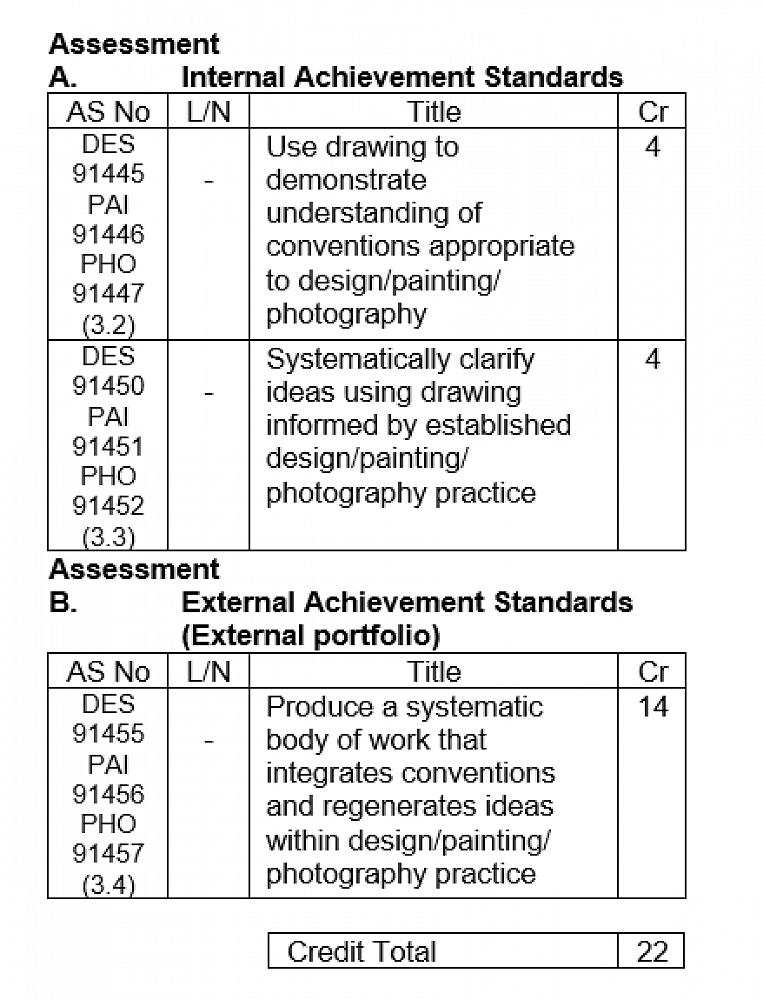Visual Arts - Design, Painting, Photography: Level 3
Qualification - NCEA level 3
Course Outline
Students studying Level 3 Visual Art are actively involved in developing an understanding of the processes and procedures involved in the making of artworks and applying this in the practice of making their own work in their chosen field(s) of study.
Students will examine the making of artworks in context, critically reflect on how meanings are communicated through interpretation of images and artefacts, build upon, extend and refine practical knowledge and further develop the ability to generate and manage ideas.
Emphasis in learning is at a critical level, whereby students use research and analysis relevant to their intentions to influence and inform their selected questions or proposal in their chosen field.
Students may choose to study one or two fields.
Prerequisite
Entry into any Level 3 Visual Art field has the prerequisite of successful completion of the appropriate Level 2 course in that field, or in consultation with the HOD of Visual Art. Please note: At the consultation meeting, prior learning and recent evidence of interest in the Visual Arts will be used to determine a student’s suitability for the course. Please ensure that this is made available.
DESIGN
Students will create a variety of work including drawings, developed sequences of work, small works, media studies, and digital images which show how ideas are developed, clarified and resolved within the context of a given design brief.
These skills will then be applied to an individual course of study relating to established design practice which will be developed in consultation with the teacher. This will involve the selection of an area of design to investigate and study. Students will refer to the work of contemporary and historical designers and design genres appropriate to their selected area of design. Students will be encouraged to explore processes and subject matter relating to their interests and strengths and to develop their work with explicit reference to design and designers and established modes of contemporary design and other artistic practice.
Students will submit bodies of work for internal assessment, and the external assessment is in the form of a three panel folio.
PAINTING
Students will create a variety of work including drawing, developed sequences of work, small works and finished paintings which show how pictorial ideas are developed, clarified and extended.
Students will develop an individual course of study relating to established painting practice in consultation with their teacher. This will involve the selection of subject matter, appropriate artist models and pictorial issues to explore in their work. Students will be encouraged to explore materials and processes and to develop their work with reference to artist models and established modes of painting practice.
Students will submit bodies of work for internal assessment, and the external assessment is in the form of a three panel folio.
PHOTOGRAPHY
Students will create a variety of work including drawing, developed sequences of work, small works and finished series of prints which show how pictorial ideas are developed, clarified and resolved. Students are actively involved in learning about photography as ‘picture-making’ and the visual potential of the medium.
Students will apply this knowledge to an individual course of study relating to established Art photography practice which is developed in consultation with their teacher. This will involve investigating and putting into practice in their own work a variety of photographic processes and procedures, both with and without the camera, and using digital and analogue media as appropriate.
Please note: It is helpful if students have access to a digital (DSLR) camera. There is currently no obligation for students to own a DSLR camera to access this subject, as the School has some cameras for loan. Should students wish to purchase a camera prior to the commencement of the course, they are advised to discuss options with the teacher in charge of Photography. Phone cameras are also suitable as long as students can make appropriate settings adjustments when needed. It is expected that students bear the individual cost of photographic materials. These can be reasonably expensive and this should be taken into consideration when selecting this course.
Visual Art Scholarship
Students can elect to enter Scholarship in consultation with their teacher and commitment to a program of extra investigative work from early in the school year. Students may enter in more than one Visual Art Scholarship discipline but should seriously consider the implications of extra work above and beyond the requirements of their NCEA work.
Scholarship Outcome Description
The student will demonstrate the ability to think and work critically, fluently and comprehensively in the production of distinctive, original work to be presented as an eight-page workbook to accompany their three-panel NCEA folio. The work will provide evidence of research, analysis and understanding of strategies.

